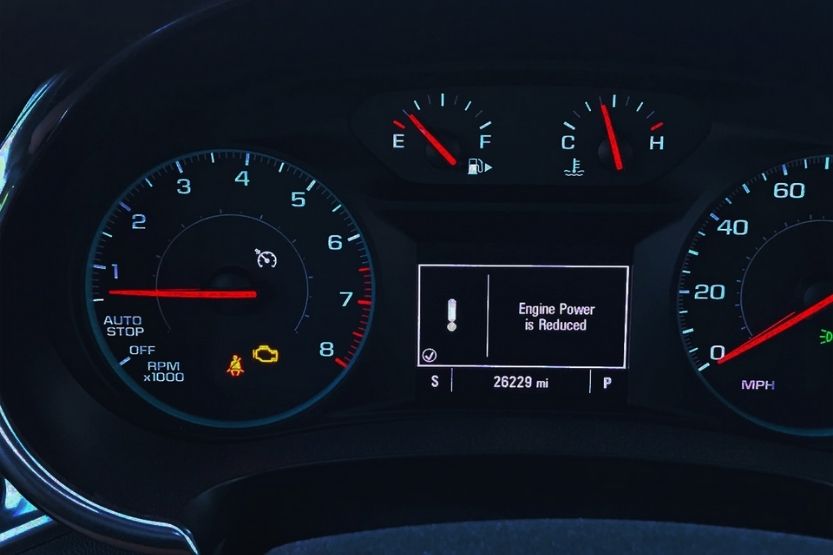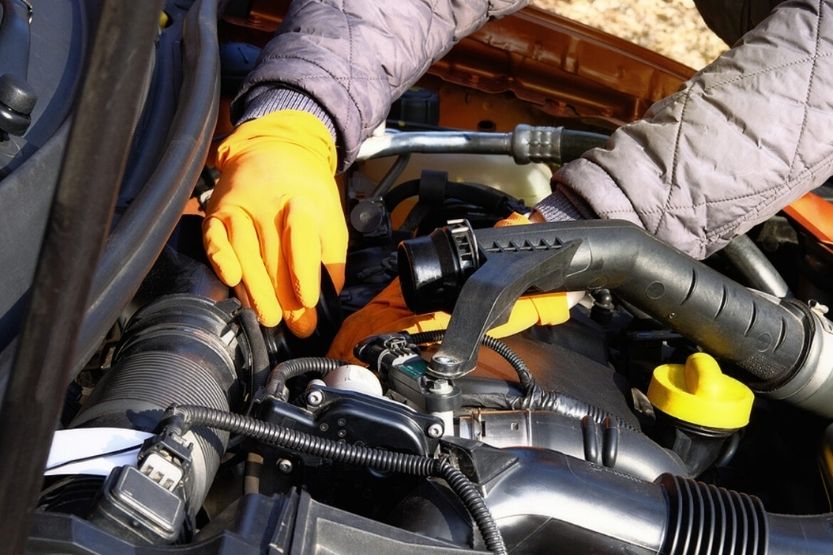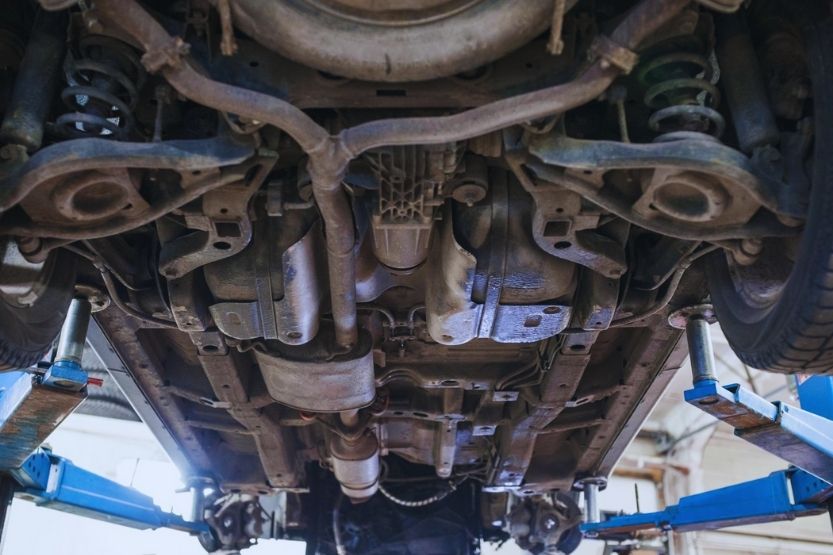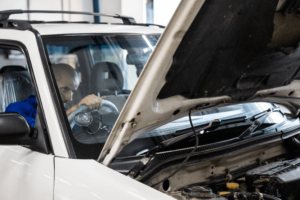It’s a good day! You are driving on the highway and listening to your favorite music. Suddenly, the check engine light turns on. You instantly panic and think – why is my check engine light on?
Below are the main reasons why the check engine light is on:
- Faulty gas cap
- Catalytic converter issues
- Damaged spark plugs
- Malfunctioning oxygen sensor
- Defective mass airflow sensor
- Bad thermostat
- Dirty fuel injector
- Air or fuel delivery problems
- Issues with the evaporative emissions control (EVAP) system
- Transmission problems
Read on to learn more about check engine light meaning, as well as what you can do to fix the problem before it escalates quickly.
Check Engine Light [10 Reasons Why It Is On]

Many drivers dread seeing the check engine light on. It does not necessarily mean that you have to stop driving if you are in the middle of the road. It can mean many things, including the following:
1. Faulty Gas Cap
Harms Engine Performance
A faulty gas cap can cause the Check Engine Light to turn on. It is common for most people to forget tightening it after filling up, or it can also suffer from wear over time, especially if you often traverse rough roads. Either way, it harms engine performance.
Prevents Fuel Contamination
The purpose of the gas cap is to seal the fuel tank. When it is tight, you can prevent dirt, dust, and debris from accumulating in the tank. It prevents fuel contamination.
Ensures the Smooth Functioning of the Evaporative Emissions System
It also ensures the smooth functioning of the evaporative emissions system, which captures and reuses fuel vapors instead of releasing them into the atmosphere.
Fuel Economy Will Suffer
Aside from the check engine light, watch out for other symptoms indicative of a faulty gas cap. You can smell the fuel most of the time, even inside your vehicle. Your fuel economy will also suffer.
Tighten the Gas Cap
The easiest solution to this problem is to tighten the gas cap. If it doesn’t tighten properly, you might need a replacement. The rubber gasket that creates a tight seal can wear out, so you might need a new cap.
2. Catalytic Converter Issues
Responsible for Transforming Harmful Compounds Into Safe Gases
The catalytic converter is a crucial component of a car’s exhaust system. It has a catalyst responsible for transforming harmful compounds into safe gases once they exit the exhaust. Also, it is located between the muffler and exhaust manifold and functions as a filter for toxic byproducts.
Inefficient Catalytic Converter Due to Clog
Like other parts, the catalytic converter is prone to damage over time, so the check engine light turns on. In an ideal scenario, it will last a lifetime. Nonetheless, it can clog, making it inefficient.
A failing catalytic converter will exhibit other symptoms aside from the check engine light. For instance, you will experience poor engine acceleration or difficulty starting.
It can indicate a clog in the catalytic converter, which can suffocate the engine and prevent it from releasing non-toxic exhaust.
Can Yield a Sulfur-like Smell
More so, problems in a catalytic converter can also yield a sulfur-like smell, which is reminiscent of rotten eggs. This is a result of the formation of hydrogen sulfide in the exhaust.
Use a Different Fuel or Fuel Additive
Proper maintenance is essential for the peak performance of the catalytic converter. Using a different fuel or fuel additive can help fix the issue. You can also remove the catalytic converter and clean it using a pressure washer to remove dirt and debris.
3. Damaged Spark Plugs
Generates Ignition for the Engine to Run
Spark plugs may be small, but they assume a significant role in your vehicle’s performance. It is a part of the internal combustion engine that uses electrical signals to create sparks. In turn, the latter generates ignition for the engine to run.
Carbon, Fuel, and Oil Build-up
Any interruption in the flow of electricity to the spark plugs will stop them from working. This can be because of carbon, fuel, and oil build-up. An excessive gap can also be the culprit for the spark plug’s malfunctioning. When these problems happen, the check engine light can turn on.
Other Signs of Faulty Spark Plugs
While the check engine light is indicative of problems with the spark plugs, it is not the only sign. You can also experience engine misfire, which results from combustion problems in the cylinder.
Rough acceleration, loud idle, difficulty starting, and poor fuel economy are other signs to watch out for.
Replace Damaged Spark Plugs
A problematic spark plug will require a replacement. Find one that matches the original component. The replacement will take roughly an hour to complete and can be an easy DIY task.
Immediately replacing it is a must. Otherwise, it can result in more serious problems, which will be costlier to fix.
4. Malfunctioning Oxygen Sensor
Measures the Vehicle’s Exhaust or Emissions
Also called the lambda sensor, the oxygen sensor is an electronic device that measures the vehicle’s exhaust or emissions, relaying this information to the onboard computer. It checks the fuel to oxygen ratio, which is crucial for combustion and peak engine performance.
Aside from the check engine light, you can detect a problem with the oxygen sensor by paying attention to other signs.
Diminish Engine Performance and Fuel Economy
For instance, it can diminish engine performance and fuel economy. The engine can also misfire and demonstrate rough idling. It is also common to have the smell of rotten eggs.
Do Not Need Regular Replacement
Unlike air and oil filters, oxygen sensors do not need regular replacement as a part of routine maintenance. Nonetheless, as soon as they fail, you need to install a new one.
Otherwise, it won’t send your vehicle’s computer the right information, sacrificing reliability. Higher emissions and damage to other parts can also be a problem.
Can Last up to 60,000 to 90,000 Miles
A new oxygen sensor can last 60,000 to 90,000 miles. However, it depends on other factors, such as the extent of use and maintenance. To check if it needs a replacement, you will need a back probe and a high-impedance digital voltmeter.
5. Defective Mass Airflow Sensor

Measure the Amount of Air That Enters an Engine
The main job of the mass airflow sensor is to measure the amount of air that enters an engine. The computer uses such information to determine how much fuel is necessary to achieve the right air-fuel ratio. Without a functioning mass airflow sensor, the engine can idle, malfunction, or not run.
Causes Mass Airflow Sensor’s Deterioration
One of the most common causes of mass airflow sensor failure is contamination. Around 9,000 liters of air enter a car’s engine for every liter of fuel that it consumes.
Along with air, dust and debris will also pass through, which contributes to the eventual deterioration of the mass airflow sensor.
Signs of a Defective Mass Airflow Sensor
If you see the check engine light on, it can indicate a defective mass airflow sensor. Consequently, another sign to look for is the jerking of the engine.
It can have abnormal jolts of power, especially when starting. Misfiring and rough idling are also common. You might also see black smoke coming out of the exhaust.
Use a Scan Tool to Confirm
If you suspect that the mass airflow sensor has a problem, you can use a scan tool to confirm your assumption. The measurement of the amount of airflow can differ depending on the RPM. The airflow readings are lower than normal when the mass airflow sensor has an issue.
6. Bad Thermostat
Maintains an Engine’s Optimal Temperature
The thermostat maintains an engine’s optimal temperature with the coolant and radiator. It prevents overheating, which also minimizes the possibility of a breakdown.
Stuck in an Open or Closed Position
When it is not working properly, it will be stuck in an open or closed position. The longer the problem is unsolved, the more serious the damages are.
Watch Out for Overheating
When the check engine light is on, a bad thermostat is one of the culprits. Nonetheless, one of the things to watch out for is overheating. The latter means a failure of proper temperature regulation, which often happens when the thermostat is not working.
Can Cause Coolant Leak
A bad thermostat can also lead to a coolant leak. The source of this leak is the gasket. The temperature gauge can also fluctuate when the thermostat is malfunctioning. Inside your car, you might feel cool and instantly warm as the thermostat fails to deliver the intended functions.
Thermostat Replacement Cost
On average, replacing a thermostat will cost anywhere from $70 to $450. This will depend on your vehicle model, as well as the location. The thermostat is incorporated into housing in some cars, making the replacement more expensive.
Again, what does a Check Engine Light mean? A solid Check Engine Light means you can continue to drive, but you need to visit your mechanic soon. Meanwhile, a flashing Check Engine Light means you have to stop driving and have a mechanic immediately check your car.
7. Dirty Fuel Injector
Receives Gas and Diesel Through a High-pressure Mist
A vehicle’s fuel delivery system has different components, and one of the most important is the fuel injector. It receives gas and diesel through a high-pressure mist. It optimizes the amount of fuel that gets into the engine.
Can Trigger an Error in the Engine’s Computer
Any problem with the fuel injector can trigger an error in the engine’s computer, and this can cause the check engine light to turn on.
Can Deteriorate Over Time Due to Contamination
Most modern fuel injectors have superior construction, and hence, they can last a lifetime. Even so, they can deteriorate over time, mainly because of contamination.
Using low-quality fuel and carbon build-up are some of the things that can speed up the damage. The rubber seals can also deteriorate, which will cause a leak.
Causes Other Issues
Aside from the check engine light, a dirty fuel injector can also cause other problems. One of the most common is a sputtering or misfiring engine. It can also have a rough idle. It can significantly reduce gas mileage as the engine becomes inefficient.
Get Commercially Available Cleaning Kits
Cleaning fuel injectors can be an easy DIY task. You will find commercially available cleaning kits. The active ingredient of the latter is polytheramine, which effectively dissolves carbon deposits. You can also prevent future build-up of such deposits by using a cleaner that contains polyisobutene.
8. Air or Fuel Delivery Problems
Correct Air-fuel Ratio Is Critical for the Engine’s Peak Performance
The right air-fuel ratio is critical for the peak performance of an engine. The control module will notice if this ratio is too much or too little. Consequently, it will reflect in the dashboard, often in the form of a warning sign from the check engine light.
Every fuel delivery system component should be working properly to ensure a proper air-fuel ratio.
Effect of Clogged Fuel Pump
For instance, if the fuel pump has clogs, it will not deliver the right amount of gas or diesel to the engine, and hence, the air-fuel ratio suffers. You will end up with a stuttering or stalling engine.
Fuel Filter Eliminates Contaminants
Another component that should be effectively working is the fuel filter. Its job is to eliminate contaminants that can get in the fuel. With dust and debris in the tank, the quality of the fuel will suffer. It will make the engine inefficient.
9. Issues with the Evaporative Emissions Control (EVAP) System

Prevents Toxic Vapors from Exiting the Exhaust
The Evaporative Emissions Control (EVAP) System is a major requirement in gas-powered vehicles to cut emissions. It prevents toxic vapors from exiting the exhaust, crucial in combating air pollution.
Can Fail Over Time Due to Age
While it is an active system, the EVAP system requires minimal maintenance. Despite this, it can fail over time, mainly because of age. You will see the engine light turning on when this happens, among other symptoms.
Unpleasant Fuel Smell
Another common indicator of a problem in the EVAP system is the smell of gas. Stand at the back of your vehicle, and if there is an unpleasant fuel smell, chances are it is because of the EVAP system. Nonetheless, as you learned above, we can also attribute this to other problems.
Consider and Exhaust and Emission System
You can consider an exhaust and emission system inspection to know if the EVAP system is the problem. When the vehicle fails at such a test, you will need to replace the canister to restore its peak performance.
10. Transmission Problems
When the check engine light is lit, it can signify that something is wrong with the transmission. The transmission has various sensors that communicate with your vehicle’s computer. Your dashboard will give the first indication as soon as it notices anything unusual.
Other Signs of a Faulty Transmission
Aside from the check engine light, pay attention to other signs of a faulty transmission. Among others, a common symptom is weird noises. You can hear whining, clunking, and humming when shifting gears. It might also feel that doing so requires more effort on your end.
Regularly Check the Transmission Fluid
To prevent transmission failure, regularly check the transmission fluid. Refill once it is below the amount that the manufacturer recommends. It is also crucial to practice proper gear switching. It will also help not to overheat the transmission.
Avoid Overloading the Car
Lastly, avoid overloading your vehicle so that the transmission won’t suffer from unnecessary strain.
Flashing vs. Solid Check Engine Light
When the check engine light turns on, you either see it as a flashing light or not. Understanding the difference between the two is key to diagnosing the problem properly. This will let you rule out other problems.
Flashing Check Engine Light Requires Immediate Attention
Either way, a flashing, and solid check engine light signify that something is wrong. If it is flashing, it often means that the problem is serious and requires your immediate attention. You should look under the hood or get in touch with a mechanic immediately before the issue escalates.
Orange or Red Check Engine Light
Meanwhile, some vehicles will not have flashing check engine lights. Instead, it changes color. Orange or red is the light’s color when the problem is serious. Otherwise, the light’s color is yellow.
What to Do When You See Engine Fault Service Now Warning
Frequently Asked Question – Why Is My Check Engine Light On?
Is It Safe to Drive with the Check Engine Light On?
It is safe to drive with the check engine light on. In most instances, you can keep driving until you reach your destination and diagnose the problem once you are at a stop.
However, if the check engine light is flashing, then it means that the problem is urgent. In this case, you have to pull over and find out what is wrong.
Can the Check Engine Light Turn off on Its Own?
The check engine light can turn off by itself. Such is especially the case if it is a minor issue. As you drive, the computer might detect that the problem has been resolved, and hence, the light will soon be off.
How Long Does It Take for the Check Engine Light to Clear?
Even after a repair, the car engine light might still be on. If the root cause has already been resolved, the internal computer needs time to process. The reset can happen after 20 cycles. You might need to drive 50 to 100 miles in some vehicles before the check engine light turns off.
What Should You Do If the Check Engine Light Comes On
Conclusion – Check Engine Light On Causes
The check engine light is one of the most important diagnostic tools. As soon as it flashes or turns solid, it is an indication that something is wrong. Most of the time, you can keep driving before fixing the issue. Nonetheless, some instances require immediate attention.
When the check engine light turns on, below are some of the things that you must watch out for:
- Faulty gas cap
- Catalytic converter issues
- Damaged spark plugs
- Malfunctioning oxygen sensor
- Defective mass airflow sensor
- Bad thermostat
- Dirty fuel injector
- Air/fuel delivery problems
- Issues with the evaporative emissions control (EVAP) system
- Transmission problems
Read next:
Check Engine Light On and Off Intermittently [Causes and Fixes]
How Long Can You Drive with Check Engine Light On?
Check Engine Light on After Oil Change [Causes and Solutions]
Engine Rebuild Cost – How Much Does It Cost to Rebuild an Engine?

![Battery Light on Dashboard [9 Reasons Why It's On] battery light on dashboard](https://roadsumo.com/wp-content/uploads/2022/03/battery-light-on-dashboard-150x150.jpg)
![Why Is My ABS Light On? [7 Common Reasons] why is my abs light on](https://roadsumo.com/wp-content/uploads/2022/04/why-is-my-ABS-light-on-150x150.jpg)


![“Check Gauges” Meaning [What Does It Mean and How to Fix] check gauges](https://roadsumo.com/wp-content/uploads/2021/11/check-gauges-150x150.jpg)

![Read more about the article OBD2 Scanners [8 Best Picks]](https://roadsumo.com/wp-content/uploads/2022/01/obd2-scanners-300x200.jpg)
![Read more about the article Audi EPC Light [What Causes It and How to Fix?]](https://roadsumo.com/wp-content/uploads/2022/04/Audi-EPC-light-300x200.jpg)
